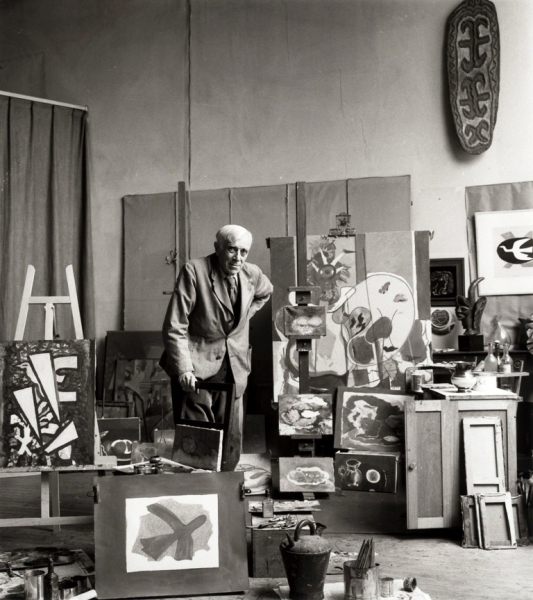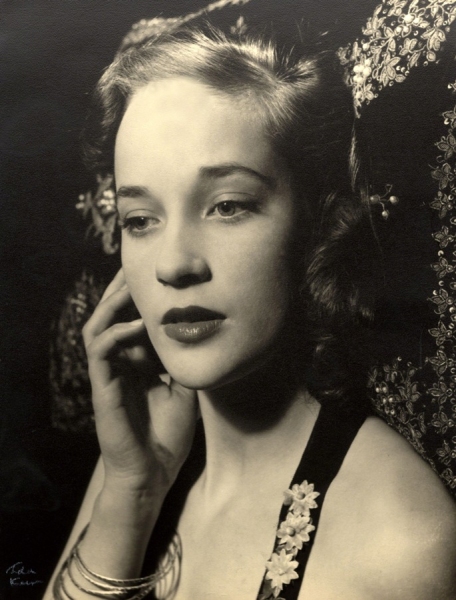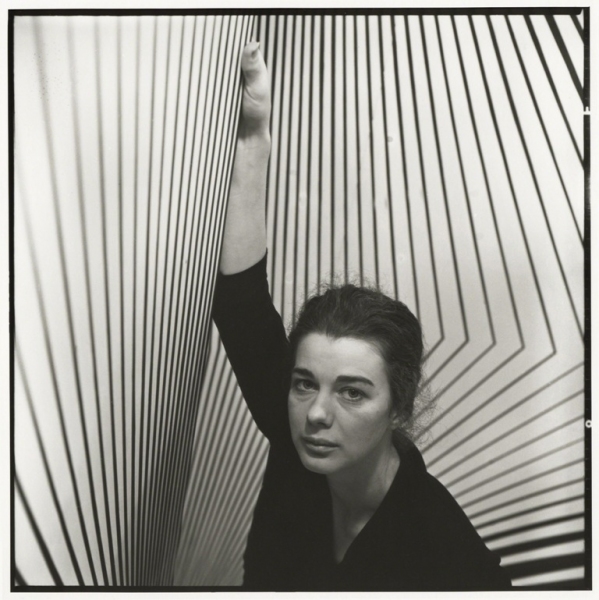Ida Kar: Bohemian Photographer, National Portrait Gallery | reviews, news & interviews
Ida Kar: Bohemian Photographer, National Portrait Gallery
Ida Kar: Bohemian Photographer, National Portrait Gallery
A forgotten, but visionary, viewer
What ever happened to Ida Kar? If the question is not quite on the level of What Ever Happened to Baby Jane?, perhaps the answer is more interesting, if less melodramatic. Ida Kar - born Ida Karamian in Russia of Armenian parents, resident of Cairo, Alexandria, Paris and Soho, the first photographer to be given a retrospective at the Whitechapel Gallery in its heyday under that curator of genius Bryan Robertson – is now, all too often, known as “Ida Who?” even by those who should know better. So, What Did Happen to Ida Kar?
The answer, sadly, is one that all too frequently occurs: not herself an exhibitionist, her chameleon-like talent was difficult to pigeonhole, and thus she slid, gently and quietly, between the cracks as the "Swinging Sixties" made those previously admired skills – clarity, perception, composition, integrity and finish – into something boring and passé. Not for Kar the slapdash, the rushed. She respected her sitters, gave them space in which to breathe – and space to promote themselves, rather than herself. Kar is notably absent from these images, while the sitters pose and preen and prance their way across her lens.
 Kar is best at creating theatrical environments out of the sitters’ own working spaces: André Breton’s apartment is pure stage set, filled with things of value, or of no value, of visual interest, or merely space-filler; Georges Braque (pictured left) appears less of a showman, but no less staged. The artist Foujita Tsugouhara is photographed in front of three puppets, so tightly cropped in around his head that he appears to be the fourth; the sculptor Kenneth Armitage sits beside one of his Standing Groups, in a pose eerily, and seemingly casually, reminiscent of the work. And Terry Frost (main picture, above), in front of his wall reliefs, and the vast sweep of his Cornish studio window, sits staring into the distance, the tools of his trade neatly laid out in front of him like a dentist’s tray.
Kar is best at creating theatrical environments out of the sitters’ own working spaces: André Breton’s apartment is pure stage set, filled with things of value, or of no value, of visual interest, or merely space-filler; Georges Braque (pictured left) appears less of a showman, but no less staged. The artist Foujita Tsugouhara is photographed in front of three puppets, so tightly cropped in around his head that he appears to be the fourth; the sculptor Kenneth Armitage sits beside one of his Standing Groups, in a pose eerily, and seemingly casually, reminiscent of the work. And Terry Frost (main picture, above), in front of his wall reliefs, and the vast sweep of his Cornish studio window, sits staring into the distance, the tools of his trade neatly laid out in front of him like a dentist’s tray.
 Some of Kar’s head shots, pure portrait images though they are, share this theatricality magicked into being through lighting and composition alone: Sylvia Syms (pictured right) at 19 is lit so that she seems to glow from inside her own transcendentally fresh beauty, not from clever lighting; while a portrait of Sartre, overpowered by a towering pile of books behind, is given two little grace notes of light eccentrically highlighting his hair and chin.
Some of Kar’s head shots, pure portrait images though they are, share this theatricality magicked into being through lighting and composition alone: Sylvia Syms (pictured right) at 19 is lit so that she seems to glow from inside her own transcendentally fresh beauty, not from clever lighting; while a portrait of Sartre, overpowered by a towering pile of books behind, is given two little grace notes of light eccentrically highlighting his hair and chin.
Sometimes Kar appears to create the sitters' characters out of thin air. Her portrait of Jacob Epstein (among the first photographs she took of an artist, soon to be her main subject) is a marvel of sly, and shy, restraint. Epstein appears in the guise of a workman, a giant in overalls, with peaked cap and huge ham-like hands held at chest height; yet under the cap are a pair of the gentlest, most wistful, most distantly focused eyes it is possible to imagine.
Other images, however, show what a fine line Kar (and her sitters) walked. The poseurs among them betray themselves in abundance. While Hans Arp positions himself neatly between two white wings of marble, turning himself into a black-and-white angel of stone, Cecil Beaton merely pouts and preens in a greenhouse, turning himself into only a caricature of his all too easily caricatured self. Other sitters either did not set Kar alight, or perhaps just failed to reveal enough for her to capture: Dmitri Shostakovich’s portrait could be any standard publicity shot or Life magazine image; Ionesco is not much more imaginatively reproduced.  Quite what the difference is, why Bridget Riley (pictured left) becomes a black-and-white-faced marvel sandwiched between her black-and-white work, while Maggie Smith remains a handsome woman posing artificially, when both are equally artificial, remains a mystery in this show, which never seeks to engage with the artistic eye behind the lens. It may also, though, be the mystery behind Kar’s disappearance from the photography scene. The line of demarcation, between talent and artistry, between celebrity and fame, was so narrow that probably even she could not define it.
Quite what the difference is, why Bridget Riley (pictured left) becomes a black-and-white-faced marvel sandwiched between her black-and-white work, while Maggie Smith remains a handsome woman posing artificially, when both are equally artificial, remains a mystery in this show, which never seeks to engage with the artistic eye behind the lens. It may also, though, be the mystery behind Kar’s disappearance from the photography scene. The line of demarcation, between talent and artistry, between celebrity and fame, was so narrow that probably even she could not define it.
- Ida Kar, Bohemian Photographer, at the National Portrait Gallery until 19 June
 Find books on Ida Kar on Amazon
Find books on Ida Kar on Amazon
Share this article
Add comment
more Visual arts
 Fantastic Machine review - photography's story from one camera to 45 billion
Love it or hate it, the photographic image has ensnared us all
Fantastic Machine review - photography's story from one camera to 45 billion
Love it or hate it, the photographic image has ensnared us all
 Yinka Shonibare: Suspended States, Serpentine Gallery review - pure delight
Weighty subject matter treated with the lightest of touch
Yinka Shonibare: Suspended States, Serpentine Gallery review - pure delight
Weighty subject matter treated with the lightest of touch
 Jane Harris: Ellipse, Frac Nouvelle-Aquitaine MÉCA, Bordeaux review - ovals to the fore
Persistence and conviction in the works of the late English painter
Jane Harris: Ellipse, Frac Nouvelle-Aquitaine MÉCA, Bordeaux review - ovals to the fore
Persistence and conviction in the works of the late English painter
 Sargent and Fashion, Tate Britain review - portraiture as a performance
London’s elite posing dressed up to the nines
Sargent and Fashion, Tate Britain review - portraiture as a performance
London’s elite posing dressed up to the nines
 Zineb Sedira: Dreams Have No Titles, Whitechapel Gallery review - a disorientating mix of fact and fiction
An exhibition that begs the question 'What and where is home?'
Zineb Sedira: Dreams Have No Titles, Whitechapel Gallery review - a disorientating mix of fact and fiction
An exhibition that begs the question 'What and where is home?'
 Yoko Ono: Music of the Mind, Tate Modern review - a fitting celebration of the early years
Acknowledgement as a major avant garde artist comes at 90
Yoko Ono: Music of the Mind, Tate Modern review - a fitting celebration of the early years
Acknowledgement as a major avant garde artist comes at 90
 Unravel: The Power and Politics of Textiles in Art, Barbican review - the fabric of dissent
An ambitious exploration of a neglected medium
Unravel: The Power and Politics of Textiles in Art, Barbican review - the fabric of dissent
An ambitious exploration of a neglected medium
 When Forms Come Alive, Hayward Gallery review - how to reduce good art to family fun
Seriously good sculptures presented as little more than playthings or jokes
When Forms Come Alive, Hayward Gallery review - how to reduce good art to family fun
Seriously good sculptures presented as little more than playthings or jokes
 Entangled Pasts 1768-now, Royal Academy review - an institution exploring its racist past
After a long, slow journey from invisibility to agency, black people finally get a look in
Entangled Pasts 1768-now, Royal Academy review - an institution exploring its racist past
After a long, slow journey from invisibility to agency, black people finally get a look in
 Barbara Kruger, Serpentine Gallery review - clever, funny and chilling installations
Exploring the lies, deceptions and hyperbole used to cajole, bully and manipulate us
Barbara Kruger, Serpentine Gallery review - clever, funny and chilling installations
Exploring the lies, deceptions and hyperbole used to cajole, bully and manipulate us
 Richard Dorment: Warhol After Warhol review - beyond criticism
A venerable art critic reflects on the darkest hearts of our aesthetic market
Richard Dorment: Warhol After Warhol review - beyond criticism
A venerable art critic reflects on the darkest hearts of our aesthetic market
 Dineo Seshee Raisibe Bopape: (ka) pheko ye / the dream to come, Kiasma, Helsinki review - psychic archaeology
The South African artist evokes the Finnish landscape in a multisensory installation
Dineo Seshee Raisibe Bopape: (ka) pheko ye / the dream to come, Kiasma, Helsinki review - psychic archaeology
The South African artist evokes the Finnish landscape in a multisensory installation

Comments
...